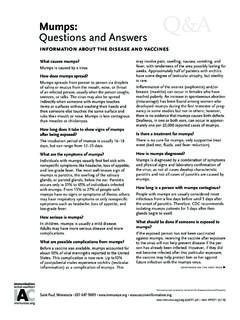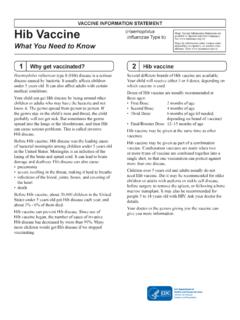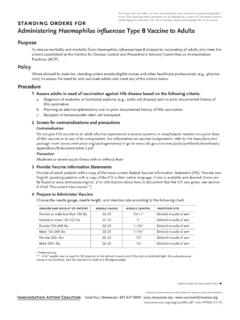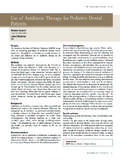Transcription of You Must Give Your Patients Vaccine Information …
1 What are Vaccine Information Statements (VISs)? Vaccine Information Statements (VISs) are documents produced by the Centers for Disease Control and Prevention (CDC), in con-sultation with panels of experts and parents, to properly inform vac-cinees (or their parents/legal representatives) about the risks and benefits of each Vaccine . VISs are not meant to replace interactions with healthcare providers, who should address any questions or concerns that the vaccinee (or parent/legal representative) may VISs is legally required!Federal law (under the National Childhood Vaccine Injury Act) requires a healthcare provider to give a copy of the current VIS to an adult patient or to a child s parent/legal representative before vaccinating an adult or child with a dose of the following vaccines: diphtheria, tetanus, pertussis, measles, mumps, rubella, polio, hepatitis A, hepatitis B, Haemophilus influenzae type b (Hib), influ enza, pneumococcal conjugate, meningococcal, rotavirus, human papillomavirus (HPV), or varicella (chicken pox).
2 Where to get VISsAll available VISs can be downloaded from the websites of the Immunization Action Coalition at or CDC at Ready to copy versions may also be available from your state or local health : You can find VISs in more than 30 languages on the Immunization Action Coalition website at You Must Give Your Patients Vaccine Information Statements (VISs) It s Federal Law!According to CDC, the appropriate VIS must be given: Prior to the vaccination (and prior to each dose of a multi-dose series); Regardless of the age of the vaccinee; Regardless of whether the Vaccine is given in a public or private healthcare obtain translations of VIS in languages other than English, go to Most current versions of VISs (table)As of February 12, 2018, the most recent versions of the VISs are as follows:A handy list of current VIS dates is also available at 10 Facts About VISsIt s federal law!
3 You must give current* VISs to all your Patients before vaccinating law requires that VISs must be used for Patients of all ages when administering these vaccines: DTaP (includes DT) MMR and MMRV Td and Tdap meningococcal (MenACWY, MenB) Hib pneumococcal conjugate hepatitis A polio hepatitis B rotavirus HPV varicella (chickenpox) influenza (inactivated and live, intranasal)For the vaccines not covered under the National Childhood Vaccine Injury Act ( , adenovirus, anthrax, Japanese encephalitis, pneu-mococcal polysaccharide, rabies, typhoid, yellow fever, and zos-ter), providers are not required by federal law to use VISs unless they have been purchased under CDC contract.
4 However, CDC rec-ommends that VISs be used whenever these vaccines are given.*Federal law allows up to 6 months for a new VIS to be can be given to Patients in a variety of most medical settings, VISs are provided to Patients (or their parents/legal representatives) in paper form. However, VISs also may be provided using electronic media. Regardless of the format used, the goal is to provide a current VIS just prior to vaccination. fact 1fact 2 Adenovirus ..6/11/14 Anthrax ..3/10/10 Chickenpox ..2/12/18 Cholera ..7/6/17 DTaP ..5/17/07 Hib ..4/2/15 Hepatitis A ..7/2 0/16 Hepatitis B ..7/2 0/16 HPV.
5 12/2/16 Influenza ..8/7/15 Japanese enceph ..1/24/14 MenACWY ..3/31/16 MenB ..8/9/16 MMR ..2/12/18 MMRV ..2/12/18 Multi- Vaccine ..11/5/15 PCV13 ..11/5/15 PPSV ..4/24/15 Polio ..7/2 0/16 Rabies ..10/6/09 Rotavirus ..4/15/15Td ..4/11/17 Tdap ..2/24/15 Typhoid ..5/29/12 Yellow fever ..3/30/11 Zoster ..2/12/18continued on next page Technical content reviewed by the Centers for Disease Control and PreventionSaint Paul, Minnesota 651-6 47-9009 Item #P2027 (2/18)(For Information on special circumstances involving vaccination of a child when a parent/legal representative is not available at the time of vaccination, see CDC s Frequently Asked Questions at ) Prior to vaccination, VIS may be.
6 Provided as a paper copy Offered on a permanent, laminated office copy Downloaded by the vaccinee (parent/legal representative) to a smartphone or other electronic device (VISs have been specially formatted for this purpose) Made available to be read before the office visit, , by giving the patient or parent a copy to take home during a prior visit, or telling them how to download or view a copy from the Internet. These Patients must still be offered a copy in one of the formats described previously to read during the immunization visit, as a of the way the patient is given the VIS to read, providers must still offer a copy (which can be an electronic copy) of each appropriate VIS to take home following the vaccination.
7 However, the vaccinee may are required in both public and private sector healthcare law requires the use of VISs in both public and private sec-tor settings, regardless of the source of payment for the must provide a current VIS before a Vaccine is administered to the VIS provides Information about the disease and the Vaccine and must be given to the patient before a Vaccine is administered. It is also acceptable to hand out the VIS well before administering vaccines ( , at a prenatal visit or at birth for vaccines an infant will receive during infancy), as long as you still provide a current VIS right before administering vaccines.
8 You must provide a current VIS for each dose of Vaccine you most current VIS must be provided before each dose of Vaccine is given, including vaccines given as a series of doses. For example, if 5 doses of a single Vaccine are required ( , DTaP), the patient (parent/legal representative) must have the opportunity to read the Information on the VIS before each dose is given. You must provide VISs whenever you administer combination you administer a combination Vaccine that does not have a stand alone VIS ( , Kinrix, Quadracel, Pediarix, Pentacel, Twin rix) you should provide the patient with individual VISs for the compo-nent vaccines, or use the Multi Vaccine VIS (see below).
9 The Multi- Vaccine VIS may be used in place of the individual VISs for DTaP, Hib, hepatitis B, polio, and pneumococcal when two or more of these vaccines are administered during the same visit. It may be used for infants as well as children through 6 years of age. The Multi Vaccine VIS should not be used for adolescents or should be given in a language/format that the recipient can understand, whenever Patients who don t read or speak English, the law requires that providers ensure all Patients (parent/legal representatives) receive a VIS, regardless of their ability to read English. To obtain VISs in more than 30 languages, visit the Immunization Action Coalition website at Providers can supplement VISs with visual presentations or oral explanations as law does not require signed consent in order for a person to be vaccinated.
10 Signed consent is not required by federal law for vaccination (although some states may require it). To verify that a VIS was given, providers must record in the patient s medical record (or perma-nent office log or file) the following Information :VISs should not be altered before giving them to Patients , but you can add some should not change a VIS or write their own VISs. However, it is permissible to add a practice s name, address, and contact Information to an existing VIS. Additional resources on VISs and their use are available from the following organizations:Immunization Action Coalition VIS general Information and translations in more than 30 languages: Current Dates of Vaccine Information Statements: for Disease Control and Prevention VIS website: VIS Facts: VIS FAQs: The edition date of the VIS The date the VIS is provided (found on the back at the ( , the date of the visit when right bottom corner) the Vaccine is administered)In addition, providers must record.















